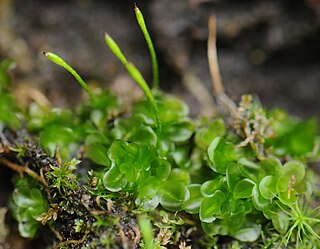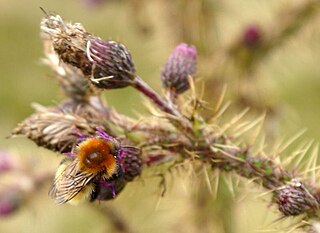
Lycoperdon is a genus of puffball mushrooms. The genus has a widespread distribution and contains about 50 species. In general, it contains the smaller species such as the pear-shaped puffball and the gem-studded puffball. It was formerly classified within the now-obsolete order Lycoperdales, as the type genus which, following a restructuring of fungal taxonomy brought about by molecular phylogeny, has been split. Lycoperdon is now placed in the family Agaricaceae of the order Agaricales.

Johann Hedwig, also styled as Johannes Hedwig, was a German botanist notable for his studies of mosses. He is sometimes called the "father of bryology". He is known for his particular observations of sexual reproduction in the cryptogams. Many of his writings were in Latin, and his name is rendered in Latin as Ioannis Hedwig or Ioanne Hedwig. The standard author abbreviation Hedw. is used to indicate this person as the author when citing a botanical name.

William Starling Sullivant was an early American botanist recognized as the foremost authority on bryophytes in the United States.

Bryology is the branch of botany concerned with the scientific study of bryophytes. Bryologists are people who have an active interest in observing, recording, classifying or researching bryophytes. The field is often studied along with lichenology due to the similar appearance and ecological niche of the two organisms, even though bryophytes and lichens are not classified in the same kingdom.

Pupilla alpicola is a species of minute air-breathing land snail, a terrestrial pulmonate gastropod mollusk or micromollusk in the family Pupillidae.

Oedipodium is the only genus of moss in the family Oedipodiaceae. It contains the single species Oedipodium griffithianum, the gouty-moss or Griffith's oedipodium moss. This species is distributed in cooler climates of Eurasia, as well as from Alaska, Washington state, British Columbia, Yukon, Greenland, Newfoundland, Tierra del Fuego and the Falkland Islands.
KarlJohannAugustMüller was a German bryologist and science popularizer.

Pupilla muscorum, commonly known as the Moss Chrysalis snail or widespread column, is a species of minute air-breathing land snail, a terrestrial pulmonate gastropod mollusk or micromollusk in the family Pupillidae.

Philoscia muscorum, the common striped woodlouse or fast woodlouse, is a common European woodlouse. It is widespread in Europe, the British Isles and is found from southern Scandinavia to Ukraine and Greece. It has also spread to Washington and many states in New England, also the mid-Atlantic states of Pennsylvania and New Jersey, as well as Nova Scotia.

Lithobius variegatus is a species of centipede found in Europe, sometimes called the common banded centipede or banded centipede.

Ligidium hypnorum is a species of woodlouse found across Europe and western Asia. It is a fast-moving, active species that rarely grows longer than 9 mm (0.35 in). It is dark and shiny, and is similar in appearance to the common species Philoscia muscorum, and also the rarer Oritoniscus flavus. In Great Britain, it was first discovered at Copthorne Common, Surrey, in 1873, and most later records are also from South East England. It is considered a good indicator species for ancient woodland.

Pupilla pratensis is a species of minute air-breathing land snail, a terrestrial pulmonate gastropod mollusk or micromollusk in the family Pupillidae. This taxon was elevated to species level in 2009.

Bombus muscorum, commonly known as the large carder bee or moss carder bee, is a species of bumblebee in the family Apidae. The species is found throughout Eurasia in fragmented populations, but is most commonly found in the British Isles. B. muscorum is a eusocial insect. The queen is monandrous, mating with only one male after leaving a mature nest to found its own. Males mate territorially and the species is susceptible to inbreeding and bottlenecks. The species builds its nests on or just under the ground in open grassland and forages very close to the nest. In recent years, populations have significantly declined due to loss of natural habitat. B. muscorum is currently listed as vulnerable in Europe by the European Red List of Bees.
Christian Friedrich Schwägrichen was a German botanist specializing in the field of bryology.

Noël Martin Joseph Necker was a German physician and botanist.

Neanura muscorum is a species of Collembola, which are commonly called springtails, in the family Neanuridae and subfamily Neanurinae. It is extremely common and most often found under bark.

Leptothorax muscorum is a species of ant of the genus Leptothorax that ranges through a variety of habitats throughout much of Europe, northern Asia, and North and Central America, with a particularly wide distribution in the palearctic. Capable of surviving in extreme Arctic-Alpine conditions, the species is perhaps the northernmost dwelling ant indigenous to the Western Hemisphere.
Acerella muscorum is a species of proturan in the family Acerentomidae. It is found in Europe and Northern Asia.















